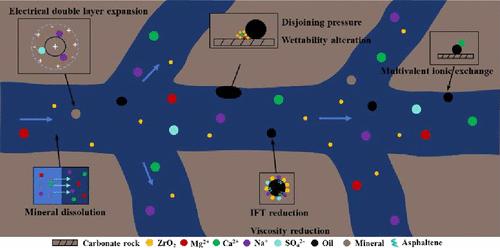当前位置:
X-MOL 学术
›
Energy Fuels
›
论文详情
Our official English website, www.x-mol.net, welcomes your feedback! (Note: you will need to create a separate account there.)
Study of Interfacial Phenomena of High Asphaltene Crude Oil with Different Salinity Water and ZrO2 Nanoparticles
Energy & Fuels ( IF 5.3 ) Pub Date : 2024-04-16 , DOI: 10.1021/acs.energyfuels.4c00287 Xuening WANG 1 , Long HE 2 , Peng XUE 2 , Yachao FENG 1 , Yan HUANG 1 , Xuefeng WANG 1
Energy & Fuels ( IF 5.3 ) Pub Date : 2024-04-16 , DOI: 10.1021/acs.energyfuels.4c00287 Xuening WANG 1 , Long HE 2 , Peng XUE 2 , Yachao FENG 1 , Yan HUANG 1 , Xuefeng WANG 1
Affiliation

|
In recent years, low-salinity waterflooding and nanofluid flooding have been regarded as the new technologies for enhanced oil recovery and research (EOR). Research on the mechanisms behind the improvement in the recovery rate has garnered significant attention. However, little attention has been given to the mechanism of low-salinity water within the high-salinity range and the synergistic mechanism between low-salinity water and nanoparticles. In the salinity range of 0–22,0,000 mg/L, the interfacial properties of different concentrations of Na+, Mg2+, Ca2+, and SO42– were investigated. The following conclusions were drawn: interfacial tension (IFT) gradually decreased at elevated temperatures, reaching a minimum value of 14.9 mN/m for 2000 mg/L low-salinity water at 60 °C. The contact angle decreased significantly at increased temperatures, reaching a minimum value of 64.8° for the contact angle of 2000 mg/L low-salinity water at 60 °C, indicating water-wet wettability. Electrostatic repulsion was the highest for 5000 mg/L low-salinity water, with a zeta potential value of −12.56 mV. Furthermore, Na+ significantly affected IFT and zeta potential values at low concentrations, while Ca2+ exhibited a more significant effect on wettability at low concentrations. Additionally, when utilizing 2000 mg/L low-salinity water as the dispersion medium for ZrO2 nanoparticles, increasing the particle concentration negatively impacted the stability of the nanofluid. As the temperature increased, IFT decreased, reaching a minimum value of 14.27 mN/m at a concentration of 0.01 wt % at 60 °C. Similarly, as the temperature increased, the contact angle decreased, with nanofluids at a concentration of 0.014 wt %, exhibiting the lowest contact angle of 51° at 60 °C, indicating increased water-wet wettability of the rock surface. This study offered a fundamental understanding of interfacial phenomena involving low-salinity water and nanoparticles, indicating their potential for EOR technology.
中文翻译:

高沥青质原油与不同矿化度水和纳米ZrO2颗粒的界面现象研究
近年来,低矿化度水驱和纳米流体驱被视为提高石油采收率和研究(EOR)的新技术。对回收率提高背后机制的研究引起了人们的广泛关注。然而,人们对高盐度范围内低盐度水的作用机制以及低盐度水与纳米颗粒之间的协同机制却很少关注。在0~22,0,000 mg/L盐度范围内,研究了不同浓度Na +、Mg 2+、Ca 2+和SO 4 2–的界面性质。得出以下结论:随着温度升高,界面张力(IFT)逐渐降低,在60℃时,2000 mg/L低盐度水的界面张力(IFT)达到最小值14.9 mN/m。随着温度的升高,接触角显着减小,在60℃时2000 mg/L低盐水的接触角达到最小值64.8°,表明水湿润湿性。 5000 mg/L低盐度水的静电斥力最高,zeta电位值为-12.56 mV。此外,Na +在低浓度下显着影响IFT和zeta电位值,而Ca 2+在低浓度下对润湿性表现出更显着的影响。此外,当使用2000 mg/L低盐度水作为ZrO 2纳米颗粒的分散介质时,增加颗粒浓度会对纳米流体的稳定性产生负面影响。随着温度升高,IFT 降低,在 60 °C 浓度为 0.01 wt% 时达到最小值 14.27 mN/m。同样,随着温度升高,接触角减小,纳米流体浓度为0.014 wt%时,在60℃时表现出最低接触角51°,表明岩石表面的水湿润湿性增加。这项研究提供了对涉及低盐水和纳米粒子的界面现象的基本了解,表明了它们在 EOR 技术中的潜力。
更新日期:2024-04-16
中文翻译:

高沥青质原油与不同矿化度水和纳米ZrO2颗粒的界面现象研究
近年来,低矿化度水驱和纳米流体驱被视为提高石油采收率和研究(EOR)的新技术。对回收率提高背后机制的研究引起了人们的广泛关注。然而,人们对高盐度范围内低盐度水的作用机制以及低盐度水与纳米颗粒之间的协同机制却很少关注。在0~22,0,000 mg/L盐度范围内,研究了不同浓度Na +、Mg 2+、Ca 2+和SO 4 2–的界面性质。得出以下结论:随着温度升高,界面张力(IFT)逐渐降低,在60℃时,2000 mg/L低盐度水的界面张力(IFT)达到最小值14.9 mN/m。随着温度的升高,接触角显着减小,在60℃时2000 mg/L低盐水的接触角达到最小值64.8°,表明水湿润湿性。 5000 mg/L低盐度水的静电斥力最高,zeta电位值为-12.56 mV。此外,Na +在低浓度下显着影响IFT和zeta电位值,而Ca 2+在低浓度下对润湿性表现出更显着的影响。此外,当使用2000 mg/L低盐度水作为ZrO 2纳米颗粒的分散介质时,增加颗粒浓度会对纳米流体的稳定性产生负面影响。随着温度升高,IFT 降低,在 60 °C 浓度为 0.01 wt% 时达到最小值 14.27 mN/m。同样,随着温度升高,接触角减小,纳米流体浓度为0.014 wt%时,在60℃时表现出最低接触角51°,表明岩石表面的水湿润湿性增加。这项研究提供了对涉及低盐水和纳米粒子的界面现象的基本了解,表明了它们在 EOR 技术中的潜力。



























 京公网安备 11010802027423号
京公网安备 11010802027423号